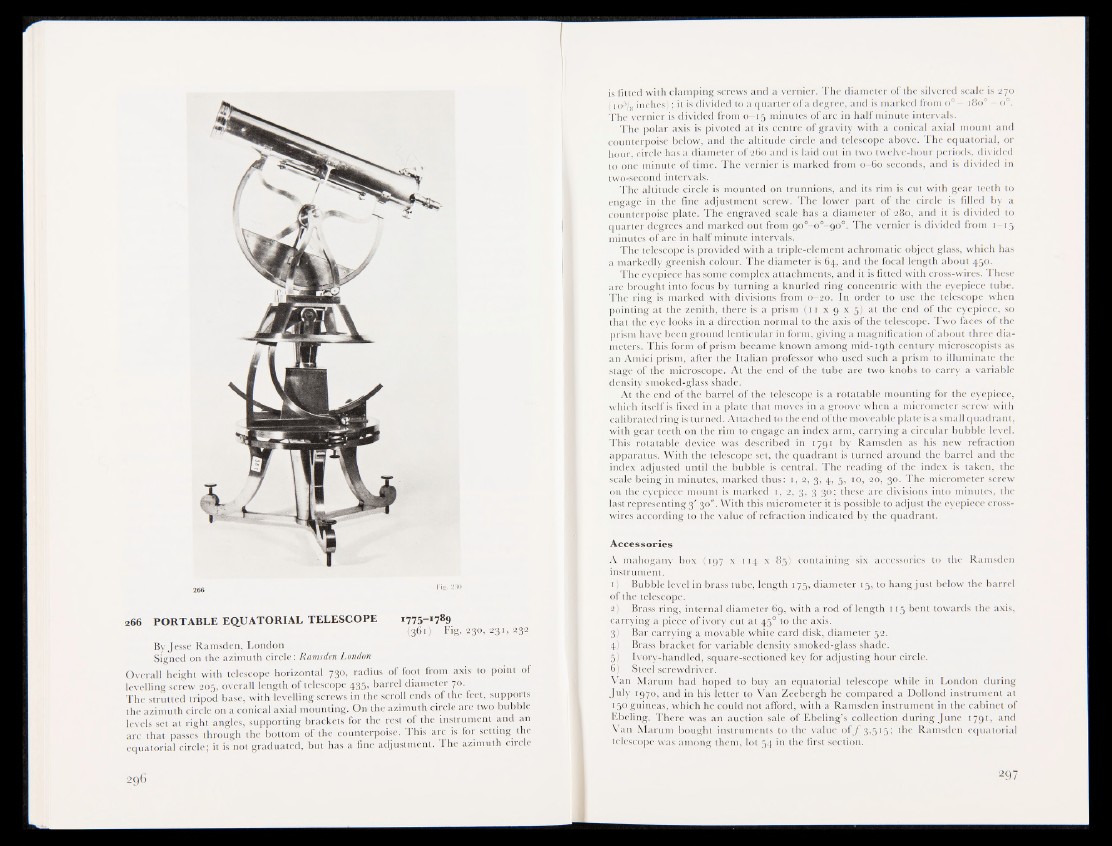
266 riS- *>u
266 PORTABLE EQUATORIAL TELESCOPE 1775- * 789
{361) Fig. 230, 231, 232
By Jesse Ramsden, London
Signed on the azimuth circle: Ramsden London
Overall height with telescope horizontal 730, radius of foot from axis to point of
levelling screw 205, overall length of telescope 435, barrel diameter p .
The strutted tripod base, with levelling screws in the scroll ends of the feet, supports
the azimuth circle on a conical axial mounting. On the azimuth circle are two bubble
levels set at right angles, supporting brackets for the rest of the instrument and an
arc that passes through the bottom of the counterpoise. This arc is for setting the
equatorial circle; it is not graduated, but has a fine adjustment. The azimuth circle
is fitted with clamping screws and a vernier. The diameter of the silvered scale is 270
( io5/8 inches); it is divided to a quarter of a degree, and is marked from o° - 180° - 0°.
The vernier is divided from 0—15 minutes of arc in half minute intervals.
The polar axis is pivoted at its centre of gravity with a conical axial mount and
counterpoise below, and the altitude circle and telescope above. The equatorial, or
hour circle has a diameter of 260 and is laid out in two twelve-hour periods, divided
to one minute of time. The vernier is marked from 0—60 seconds, and is divided in
two-second intervals.
The altitude circle is mounted on trunnions, and its rim is cut with gear teeth to
engage in the fine adjustment screw. The lower part of the circle is filled by a
counterpoise plate. The engraved scale has a diameter of 280, and it is divided to
quarter degrees and marked out from 90° o° 90°. The vernier is divided from 1—15
minutes of arc in half minute intervals.
The telescope is provided with a triple-element achromatic object glass, which has
a markedly greenish colour. The diameter is 64, and the focal length about 450.
The eyepiece has some complex attachments, and it is fitted with cross-wires. These
are brought into focus by turning a knurled ring concentric with the eyepiece tube.
The ring is marked with divisions from Q||gJ§>. In order to use the telescope when
pointing at the zenith, there & a prism | l 1 x 9 x 5) at the end of the eyepiece, so
that the eye looks in ,a.direction normal to the axis of the telescope. Two faces of the
prism have been ground lenticular in form, giving a magnification of about three diameters.
This form of prism became known among mid-19th century microscopists as
an Amici prism, after the Italian professor who used such a prism to illuminate the
stage of the microscope. At the end of the tube are two knobs to carry a variable
density smoked-glass shade.
At the end of the barrel of||h# telescope is a rotatable mounting for the eyepiece,
which itself Is fixed in a plate that moves in a groove when a micrometer screw with
calibrated ring is turned. Attached to the end of the moveable plate is a small quadrant,
with gear teeth on the rim to engage an index arm, carrying a circular bubble level.
This rotatable device was described in 1791 by Ramsden as his new refraction
apparatus. With the telescope set, the quadrant is turned around the barrel and the
index adjusted until the bubble is central. The reading of the index is taken, the
scale being in fflinutes^Jmarked thus; 1, 2, 3, 4, 5, 10, 20, 30. The micrometer screw
on the eyepiece mount is marked 1, 2, 3, 3 30: these are divisions into minutes, the
last representing 3' 30". With this micrometer it is possible to adjust the eyepiece crosswires
according to the value of refraction indicated by the quadrant.
Accessories
A mahogany box (197 x 114 x 85) BSihtaining six accessories to the Ramsden
instrument.
1) Bubble level in brass tube, length 175, diameter 15, to hang just below the barrel
of the telescope.
2II Brass ring, internal diameter 69, with a rod of length 115 bent towards the axis,
carrying a piece of ivory cut at 45° to the axis.
3H Bar carrying a movable white card disk, diameter 52.
4) Brass bracket for variable density smoked-glass shade.
59 Ivory-handled, square-sectioned key for adjusting hour circle.
6) Steel screwdriver.
Van Marum had hoped to buy an equatorial telescope while in London during
July 1970, and in his letter to Van Zeebergh he compared a Dollond instrument at
150 guineas, which he could not afford, with a Ramsden instrument in the cabinet of
Ebeling. There was an auction sale of Ebeling’s collection during June 1791, and
Van Marum bought instruments to the value of f 3,515; the Ramsden equatorial
telescope was among them, lot 54 in the first section.